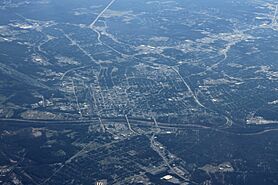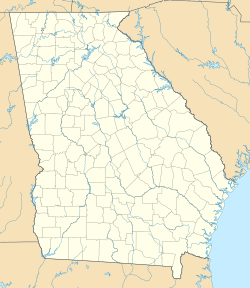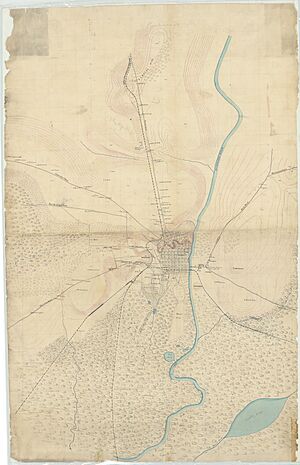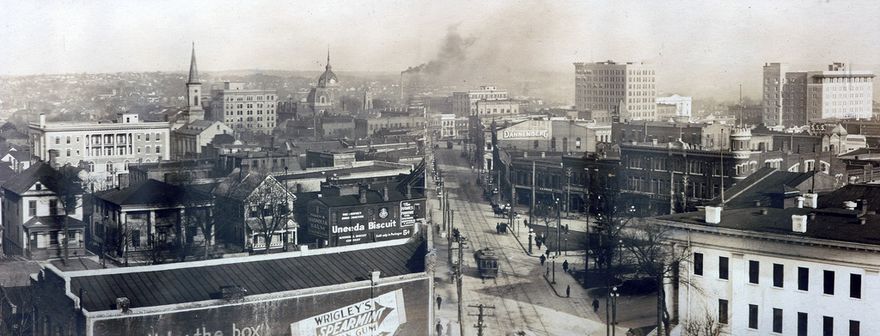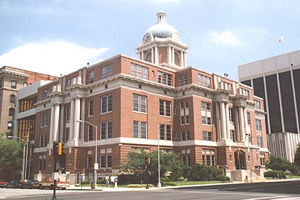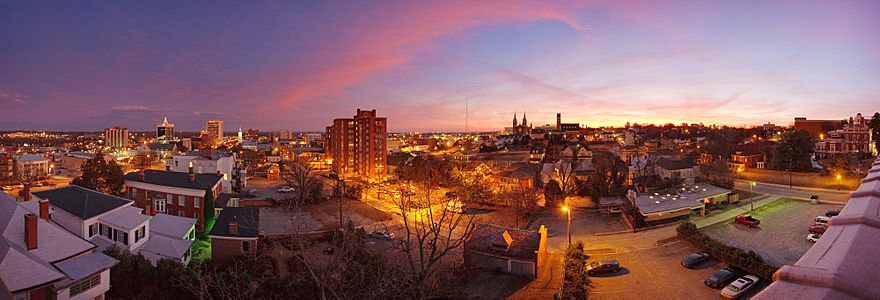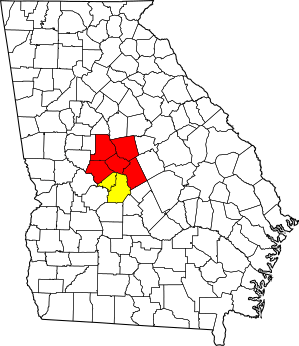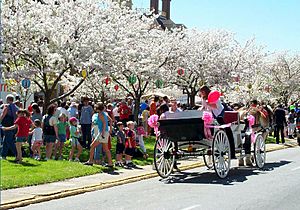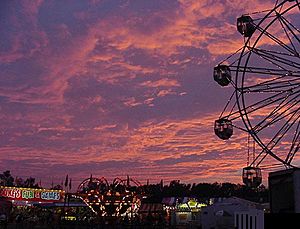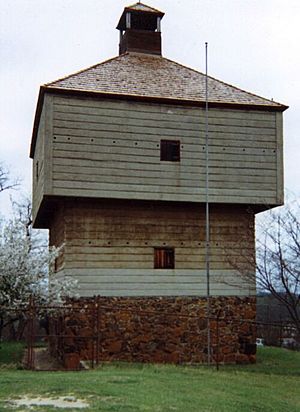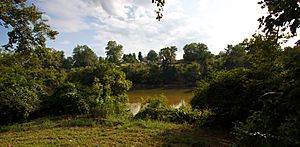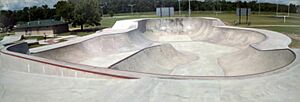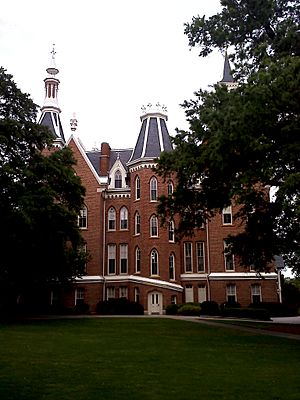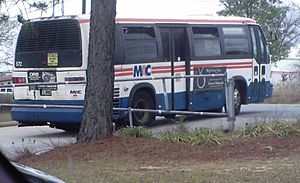Macon, Georgia facts for kids
Quick facts for kids
Macon
|
||
|---|---|---|
|
Consolidated city-county
|
||
| Macon–Bibb County | ||
|
Aerial photograph of Macon
Bibb County Courthouse
|
||
|
||
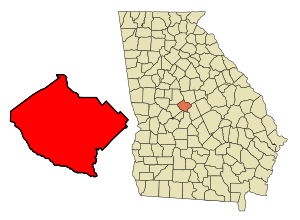
Location within Bibb County
|
||
| Country | United States | |
| State | Georgia | |
| County | Bibb | |
| Settled around Fort Benjamin Hawkins | 1809 | |
| Named for | Nathaniel Macon | |
| Area | ||
| • Consolidated city-county | 254.90 sq mi (660.19 km2) | |
| • Land | 249.38 sq mi (645.89 km2) | |
| • Water | 5.52 sq mi (14.30 km2) | |
| Elevation | 381 ft (116 m) | |
| Population
(2020)
|
||
| • Consolidated city-county | 157,346 | |
| • Rank | ||
| • Density | 630.95/sq mi (243.61/km2) | |
| • Metro | 233,802 (197th) | |
| Time zone | UTC−5 (EST) | |
| • Summer (DST) | UTC−4 (EDT) | |
| ZIP Codes |
31200–31299
|
|
| Area code(s) | 478 | |
| FIPS code | 13-49000 | |
| GNIS feature ID | 0332301 | |
| Website | maconbibb.us | |
Macon (/ˈmeɪkən/ MAY-kən), officially Macon–Bibb County, is a consolidated city-county in Georgia, United States. Situated near the fall line of the Ocmulgee River, it is 85 miles (137 km) southeast of Atlanta and near the state's geographic center—hence its nickname "The Heart of Georgia".
Macon's population was 157,346 in the 2020 census. It is the principal city of the Macon metropolitan statistical area, which had 234,802 people in 2020. It also is the largest city in the Macon–Warner Robins Combined Statistical Area (CSA), which had approximately 420,693 residents in 2017 and abuts the Atlanta metropolitan area to the northwest.
Voters approved the consolidation of the City of Macon and Bibb County governments in a 2012 referendum. Macon became the state's fourth-largest city (after Augusta) when the merger became official on January 1, 2014.
Macon is served by three interstate highways: I-16 (connecting to Savannah and coastal Georgia), I-75 (connecting to Atlanta to the north and Valdosta to the south), and I-475 (a city bypass highway). The area has two small general aviation airports, Middle Georgia Regional Airport and Herbert Smart Downtown Airport. Residents traveling to and from the area mainly use the large commercial airport in Atlanta, approximately 80 miles to the northwest.
The city has several institutions of higher education and numerous museums and tourism sites.
Contents
History
Macon was founded on the site of the Ocmulgee Old Fields, where the Creek Indians lived in the 18th century. Their predecessors, the Mississippian culture, built a powerful agriculture-based chiefdom (950–1100 AD). The Mississippian culture constructed earthwork mounds for ceremonial, religious, and burial purposes. Indigenous peoples inhabited the areas along the Southeast's rivers for 13,000 years before Europeans arrived.
Macon was developed at the site of Fort Benjamin Hawkins, built in 1809 at President Thomas Jefferson's direction after he forced the Creek to cede their lands east of the Ocmulgee River. (Archeological excavations in the 21st century found evidence of two separate fortifications.) The fort was named for Benjamin Hawkins, who served as Superintendent of Indian Affairs for the Southeast territory south of the Ohio River for more than 20 years, had lived among the Creek, and was married to a Creek woman. Located at the fall line of the Ocmulgee River, the fort established a trading post with Native peoples at the river's most inland point navigable from the Low Country.
Fort Hawkins guarded the Lower Creek Pathway, an extensive and well-traveled American Indian network that the U.S. government later improved as the Federal Road, linking Washington, D.C., to the ports of Mobile, Alabama and New Orleans, Louisiana. Used for trading with the Creek, the fort also was used by state militia and federal troops. It was a major military distribution point during the War of 1812 and the Creek War of 1813. After the wars, it was a trading post and garrisoned troops until 1821. Decommissioned around 1828, it later burned to the ground. A replica of the southeast blockhouse was built in 1938 and stands on an east Macon hill. Fort Hawkins Grammar School occupied part of the site. In the 21st century, archeological excavations have revealed more of the fort, increasing its historical significance, and led to further reconstruction planning for this major historical site.
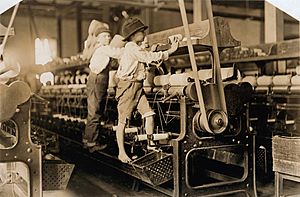
With the arrival of more settlers, Fort Hawkins was renamed "Newtown". After Bibb County's organization in 1822, the city was chartered as the county seat in 1823 and officially named Macon, in honor of Nathaniel Macon, a statesman from North Carolina, from where many early Georgia residents hailed. City planners envisioned "a city within a park" and created a city of spacious streets and landscapes. Over 250 acres (1.0 km2) were dedicated for Central City Park, and ordinances required residents to plant shade trees in their front yards.
Because of the beneficial local Black Belt geology and the availability of slave labor, cotton became the mainstay of Macon's early economy. The city's location on the Ocmulgee River aided initial economic expansion, providing shipping access to new markets. Cotton steamboats, stagecoaches, and the 1843 arrival of the railroad increased marketing opportunities and contributed to Macon's economic prosperity.
Macon's growth had other benefits. In 1836, the Georgia Conference of the Methodist Episcopal Church chose Macon as the location for Wesleyan College, the first U.S. college to grant women college degrees. Nonetheless, Macon came in last in the 1855 referendum voting to be Georgia's capital city with 3,802 votes.
During the American Civil War, Macon served as the official arsenal of the Confederacy manufacturing percussion caps, friction primers, and pressed bullets. Camp Oglethorpe was established as a prison for captured Union officers and enlisted men. Later, it held only officers, at one time numbering 2,300. The camp was evacuated in 1864.
Macon City Hall served as the temporary state capitol in 1864 and was converted to a hospital for wounded Confederate soldiers. The Union General William Tecumseh Sherman spared Macon on his march to the sea. His troops sacked the nearby state capital of Milledgeville, and Maconites prepared for an attack. Sherman, however, passed by without entering Macon.
The Macon Telegraph reported the city had furnished 23 companies of men for the Confederacy, but casualties were high. By war end, Maconite survivors fit for duty could fill only five companies.
The city was taken by Union forces during Wilson's Raid on April 20, 1865.
Because of its central location, Macon developed as a state transportation hub. In 1895, the New York Times dubbed Macon "The Central City" because of is emergence as a railroad transportation and textile factory hub. Terminal Station was built in 1916. In the twentieth century, Macon grew into a prospering town in Middle Georgia.
Macon has been impacted by natural catastrophes. In 1994 Tropical Storm Alberto made landfall in Florida and flooded several Georgia cities. Macon, which received 24 inches (61 cm) of rain, suffered major flooding.
On May 11, 2008, an EF2 tornado hit Macon. Touching down in nearby Lizella, the tornado moved along the southern shore of Lake Tobesofkee, continued into Macon, and lifted in Twiggs County. The storm's total path length was 18 miles (29 km), and its path width was 100 yards (91 m). The tornado produced sporadic areas of major damage, with widespread straight-line wind damage to the south of its path. The most significant damage was along Eisenhower Parkway and Pio Nono Avenue in Macon, where two businesses were destroyed and several others were heavily damaged. The tornado also impacted Macon State College, where almost 50% of the campus's trees were snapped or uprooted and several buildings were damaged, with the gymnasium. The tornado's intensity varied from EF0 to EF2, with the EF2 damage and winds up to 130 miles per hour (210 km/h) occurring near the intersection of Eisenhower Parkway and Pio Nono Avenue.
Consolidation
On July 31, 2012, voters in Macon (57.8 percent approval) and Bibb County (56.7 percent approval) passed a referendum to merge the governments of the city of Macon and most of unincorporated Bibb County. The vote came after the Georgia General Assembly passed House Bill 1171, authorizing the referendum earlier in the year; Four previous consolidation attempts (in 1933, 1960, 1972, and 1976) failed.
As a result of the referendum, (i) the Macon and Bibb County governments were replaced with a mayor and a nine-member county commission elected by districts and (ii) a portion of Macon extending into nearby Jones County was disincorporated. Robert Reichert was elected the first mayor of Macon-Bibb in the September 2013 election, which required a runoff with C. Jack Ellis in October.
Geography
The Ocmulgee River is a major river that runs through the city. Macon is one of Georgia's three major Fall Line Cities, along with Augusta and Columbus. The Fall Line is where the hills of the Piedmont plateau meet the flat terrain of the coastal plain. As such, Macon has a varied landscape of rolling hills on the north side and flat plains on the south. The fall line, where the elevation drops noticeably, causes rivers and creeks in the area to flow rapidly toward the ocean. In the past, Macon and other Fall Line cities had many textile mills powered by the rivers.
Macon is located at 32°50′05″N 83°39′06″W / 32.834839°N 83.651672°W (32.834839, −83.651672).
According to the United States Census Bureau, the city has a total area of 56.3 square miles (146 km2), of which 55.8 square miles (145 km2) is land and 0.5 square miles (1.3 km2) (0.82%) is water.
Macon is approximately 330 feet (100 m) above sea level.
Climate
Macon has a humid subtropical climate (Köppen climate classification Cfa). The normal monthly mean temperature ranges from 46.3 °F (7.9 °C) in January to 81.8 °F (27.7 °C) in July. On average, there are 4.8 days with 100 °F (38 °C)+ highs, 83 days with 90 °F (32 °C)+ highs, and 43 days with a low at or below freezing; the average window for freezing temperatures is November 7 thru March 22, allowing a growing season of 228 days.
The city has an average annual precipitation of 45.7 inches (1,160 mm). The wettest day on record was July 5, 1994, with 10.25 inches (260 mm) of rain, and the wettest month on record was July 1994, with 18.16 inches (461 mm) of rain. On the other hand, since 1892, when precipitation records for the city began, there have been two months, October 1961 and October 1963, which did not even record a trace of precipitation in the city, and two other months, October 1939 and May 2007, which only recorded a trace. Snow is occasional, with about half of the winters receiving trace amounts or no snowfall, averaging 0.7 inches (1.8 cm); the snowiest winter was 1972−73 with 16.5 in (42 cm).
| Climate data for Macon, Georgia (Middle Georgia Regional Airport), 1991−2020 normals, extremes 1892−present | |||||||||||||
|---|---|---|---|---|---|---|---|---|---|---|---|---|---|
| Month | Jan | Feb | Mar | Apr | May | Jun | Jul | Aug | Sep | Oct | Nov | Dec | Year |
| Record high °F (°C) | 84 (29) |
85 (29) |
92 (33) |
96 (36) |
100 (38) |
108 (42) |
108 (42) |
105 (41) |
105 (41) |
103 (39) |
88 (31) |
83 (28) |
108 (42) |
| Mean maximum °F (°C) | 73.9 (23.3) |
76.8 (24.9) |
83.9 (28.8) |
88.0 (31.1) |
93.6 (34.2) |
97.5 (36.4) |
99.1 (37.3) |
98.7 (37.1) |
95.1 (35.1) |
88.9 (31.6) |
81.8 (27.7) |
75.9 (24.4) |
100.3 (37.9) |
| Mean daily maximum °F (°C) | 59.3 (15.2) |
63.4 (17.4) |
70.6 (21.4) |
77.9 (25.5) |
85.8 (29.9) |
90.9 (32.7) |
93.5 (34.2) |
92.2 (33.4) |
87.6 (30.9) |
78.9 (26.1) |
69.1 (20.6) |
61.3 (16.3) |
77.5 (25.3) |
| Daily mean °F (°C) | 47.6 (8.7) |
51.2 (10.7) |
57.7 (14.3) |
64.5 (18.1) |
72.9 (22.7) |
79.5 (26.4) |
82.5 (28.1) |
81.4 (27.4) |
76.2 (24.6) |
66.0 (18.9) |
55.8 (13.2) |
49.5 (9.7) |
65.4 (18.6) |
| Mean daily minimum °F (°C) | 35.9 (2.2) |
39.1 (3.9) |
44.9 (7.2) |
51.0 (10.6) |
60.0 (15.6) |
68.1 (20.1) |
71.5 (21.9) |
70.7 (21.5) |
64.8 (18.2) |
53.2 (11.8) |
42.5 (5.8) |
37.8 (3.2) |
53.3 (11.8) |
| Mean minimum °F (°C) | 19.0 (−7.2) |
22.4 (−5.3) |
27.2 (−2.7) |
34.8 (1.6) |
45.0 (7.2) |
58.3 (14.6) |
64.8 (18.2) |
62.1 (16.7) |
51.1 (10.6) |
35.6 (2.0) |
26.5 (−3.1) |
22.8 (−5.1) |
17.0 (−8.3) |
| Record low °F (°C) | −6 (−21) |
8 (−13) |
14 (−10) |
28 (−2) |
40 (4) |
46 (8) |
54 (12) |
55 (13) |
35 (2) |
26 (−3) |
10 (−12) |
5 (−15) |
−6 (−21) |
| Average precipitation inches (mm) | 4.32 (110) |
4.17 (106) |
4.31 (109) |
3.62 (92) |
2.65 (67) |
4.44 (113) |
4.79 (122) |
4.38 (111) |
3.66 (93) |
2.63 (67) |
3.37 (86) |
4.57 (116) |
46.91 (1,192) |
| Average snowfall inches (cm) | 0.4 (1.0) |
0.0 (0.0) |
0.2 (0.51) |
0.0 (0.0) |
0.0 (0.0) |
0.0 (0.0) |
0.0 (0.0) |
0.0 (0.0) |
0.0 (0.0) |
0.0 (0.0) |
0.0 (0.0) |
0.1 (0.25) |
0.7 (1.8) |
| Average precipitation days (≥ 0.01 in) | 10.2 | 9.2 | 9.4 | 8.2 | 7.5 | 11.2 | 11.3 | 10.2 | 7.1 | 6.3 | 7.7 | 9.4 | 107.7 |
| Average snowy days (≥ 0.1 in) | 0.3 | 0.2 | 0.1 | 0.0 | 0.0 | 0.0 | 0.0 | 0.0 | 0.0 | 0.0 | 0.0 | 0.1 | 0.7 |
| Average relative humidity (%) | 70.2 | 67.2 | 66.6 | 64.8 | 68.5 | 70.7 | 74.2 | 76.1 | 76.4 | 71.2 | 71.1 | 70.9 | 70.7 |
| Mean monthly sunshine hours | 179.5 | 192.2 | 250.8 | 283.2 | 315.3 | 300.0 | 293.9 | 288.0 | 247.4 | 253.7 | 200.2 | 182.2 | 2,986.4 |
| Percent possible sunshine | 56 | 62 | 67 | 73 | 73 | 70 | 67 | 70 | 67 | 72 | 64 | 59 | 67 |
| Source: NOAA (snow 1981–2010, relative humidity and sun 1961−1990) | |||||||||||||
Surrounding cities and towns
Demographics
| Historical population | |||
|---|---|---|---|
| Census | Pop. | %± | |
| 1840 | 3,297 | — | |
| 1850 | 5,720 | 73.5% | |
| 1860 | 8,247 | 44.2% | |
| 1870 | 10,810 | 31.1% | |
| 1880 | 12,749 | 17.9% | |
| 1890 | 22,746 | 78.4% | |
| 1900 | 23,272 | 2.3% | |
| 1910 | 40,665 | 74.7% | |
| 1920 | 52,995 | 30.3% | |
| 1930 | 53,829 | 1.6% | |
| 1940 | 57,865 | 7.5% | |
| 1950 | 70,252 | 21.4% | |
| 1960 | 69,764 | −0.7% | |
| 1970 | 122,423 | 75.5% | |
| 1980 | 116,896 | −4.5% | |
| 1990 | 106,612 | −8.8% | |
| 2000 | 97,255 | −8.8% | |
| 2010 | 91,351 | −6.1% | |
| 2020 | 157,346 | 72.2% | |
| U.S. Decennial Census 1850-1870 1870-1880 1890-1910 1920-1930 1940 1950 1960 1970 1980 1990 2000 2010 2020 |
|||
Macon is the largest principal city in the Macon-Warner Robins-Fort Valley CSA, a combined statistical area that includes the Macon metropolitan area (Bibb, Crawford, Jones, Monroe, and Twiggs counties) and the Warner Robins metropolitan area (Houston, Peach, and Pulaski counties) with a combined population of 411,898 in the 2010 census.
| Race / Ethnicity (NH = Non-Hispanic) | Pop 2000 | Pop 2010 | Pop 2020 | % 2000 | % 2010 | % 2020 |
|---|---|---|---|---|---|---|
| White alone (NH) | 34,050 | 25,296 | 56,787 | 35.01% | 27.69% | 36.09% |
| Black or African American alone (NH) | 60,503 | 61,768 | 85,234 | 62.21% | 67.62% | 54.17% |
| Native American or Alaska Native alone (NH) | 177 | 146 | 281 | 0.18% | 0.16% | 0.18% |
| Asian alone (NH) | 608 | 683 | 3,209 | 0.63% | 0.75% | 2.04% |
| Pacific Islander alone (NH) | 27 | 28 | 42 | 0.03% | 0.03% | 0.03% |
| Other race alone (NH) | 60 | 97 | 602 | 0.06% | 0.11% | 0.38% |
| Mixed race or Multiracial (NH) | 664 | 1,069 | 4,454 | 0.68% | 1.17% | 2.83% |
| Hispanic or Latino (any race) | 1,166 | 2,264 | 6,737 | 1.20% | 2.48% | 4.28% |
| Total | 97,255 | 91,351 | 157,346 | 100.00% | 100.00% | 100.00% |
As of the official 2010 U.S. census, the population of Macon was 91,351. In the last official census, in 2000, there were 97,255 people, 38,444 households, and 24,219 families residing in the city. The population density was 1,742.8 inhabitants per square mile (672.9/km2). There were 44,341 housing units at an average density of 794.6 per square mile (306.8/km2). The racial makeup of the city was 67.94% African American, 28.56% White, 0.02% Native American, 0.65% Asian, 0.03% Pacific Islander, 0.46% from other races, and 0.77% from two or more races. Hispanic or Latino people of any race were 2.48% of the population. By the 2020 census, its population increased to 157,346.
There were 38,444 households, out of which 30.1% had children under the age of 18 living with them, 33.0% were married couples living together, 25.7% had a female householder with no husband present, and 37.0% were non-families. 31.7% of all households were made up of individuals, and 12.1% had someone living alone who was 65 years of age or older. The average household size was 2.44 and the average family size was 3.08.
In the city, the population was spread out, with 26.9% under the age of 18, 11.3% from 18 to 24, 27.5% from 25 to 44, 20.0% from 45 to 64, and 14.3% who were 65 years of age or older. The median age was 34 years. For every 100 females, there were 79.7 males. For every 100 females aged 18 and over, there were 72.8 males.
Economy
The aerospace, advanced manufacturing, food processing, healthcare, professional services, and warehouse and distribution industries drive the economy in Macon-Bibb County. Long-standing large private employers include Mercer University, GEICO's Southeast Corporate Headquarters, YKK USA, and Norfolk Southern Railway's Brosnan Yard.
The decline of the textile industry in the South, along with the shuttering of other large manufacturing operations, such as the closing of the Brown and Williamson plant in 2006, caused a decline in the city's economy in the 2000s. In recent years, the city has successfully landed numerous new employers to diversify the economy, such as Irving Consumer Products and Kuhmo Tire manufacturing plants, as well as multiple aerospace employers at the Middle Georgia Regional Airport, including an Embraer aircraft maintenance facility.
The health care and social assistance sector is the largest industry in Macon by number of employees, with the Atrium Health Navicent and Piedmont Healthcare Macon hospital systems, two of the city's largest employers, making Macon the healthcare hub for the Middle and South Georgia regions.
Personal income
The 2010 Census listed Macon's median household income as $28,366, below the state average of $49,347. The median family income was $37,268. Full-time working males had a median income of $34,163, higher than the $28,082 for females. The city's per capita income was $17,010. About 24.1% of families and 30.6% of the population were below the poverty line, including 43.6% of those under age 18 and 18.4% of those over 65.
Retail
Malls include The Shoppes at River Crossing, Macon Mall, and Eisenhower Crossing. Traditional shopping centers are in the downtown area and Ingleside Village.
Military
Macon is the headquarters of the 48th Infantry Brigade Combat Team, Georgia Army National Guard.
The largest single-site industrial complex in Georgia, Robins Air Force Base, is 10 miles south of Macon on Highway 247, just east of Warner Robins.
Arts and culture
Musical heritage
Macon has been home for numerous musicians and composers, including Emmett Miller, The Allman Brothers Band, Randy Crawford, Mark Heard, Lucille Hegamin, Ben Johnston, Otis Redding, Little Richard, Mike Mills, and Bill Berry of R.E.M., as well as more recent artists like violinist Robert McDuffie and country artist Jason Aldean. Capricorn Records, run by Macon natives Phil Walden and briefly Alan Walden, made the city a Southern rock music production center in the late 1960s and 1970s.
The Macon Symphony Orchestra, a youth symphony, and the Middle Georgia Concert Band perform at the Grand Opera House in downtown Macon.
The Georgia Music Hall of Fame was located in Macon from 1996 to 2011.
Festivals
- International Cherry Blossom Festival - a 10-day celebration held every mid-March in Macon.
- The Mulberry Street Festival - an arts and crafts festival held downtown the last weekend of March.
- The Juneteenth Freedom Festival - An annual June performing arts and educational celebration of the end of American slavery in 1865, celebrating black freedom and heritage both ancient and contemporary.
- Pan African Festival - An annual celebration of the African diaspora and culture, held in April
- Ocmulgee Indigenous Celebration - A celebration of the original residents of the land where Macon now sits, this festival is held every third weekend in September at Ocmulgee Mounds National Historical Park. Representatives from the Cherokee, Chickasaw, Choctaw, Creek, Seminole, and other nations come to share stories, exhibit Native art, and perform traditional songs and dance.
- Skydog is a music festival celebrating the birthday, life, and music of Skydog (Duane Allman) held in November.
- The Georgia Music Hall of Fame hosts Georgia Music Week in September.
- Macon's annual Bragg Jam festival features an Art and Kids' Festival along the Ocmulgee Heritage Trail and a nighttime Pub Crawl.
- Macon Film Festival - an annual celebration of independent films, held the third weekend in July
Points of interest
Historical sites
- Terminal Station, a railroad station built in 1916, is located on 5th St. at the end of Cherry St. Its architect was Alfred Fellheimer, prominent for his 1903 design of Grand Central Terminal in New York City.
- Ocmulgee Mounds National Historical Park is located near downtown Macon. It preserves some of Georgia's largest ancient earthwork mounds built by the Mississippian culture a millennium ago, c. 950–1150. It was sacred to the historic Muscogee (Creek Nation) as well. Archeological artifacts reveal 13,000 years of human habitation at the site. The park features a spiral mound, funeral mound, temple mounds, burial mounds, and a reconstructed earth lodge. It is the first Traditional Cultural Property designated by the National Park Service east of the Mississippi River.
- Fort Benjamin Hawkins, a major military outpost (1806–1821), was a command headquarters for the U.S. Army and Georgia militia on the boundary between U.S.-held and Native land, as well as a trading post or factory for the Creek Nation. It was a supply depot during U.S. campaigns of the War of 1812 and the Creek and Seminole Wars.
- Cannonball House, a historic home on the National Register of Historic Places.
- Luther Williams Field
- Old City Cemetery, one of Macon's oldest cemeteries
- Rose Hill Cemetery, a cemetery listed on the National Register of Historic Places
- Sidney Lanier Cottage, the poet's historic home.
- Temple Beth Israel, a domed Neoclassical built in 1902 to house Macon's Jewish congregation, founded in 1859.
- Wesleyan College, the first chartered women's college in the world
Museums
- The Allman Brothers Band Museum - the "Big House" used by the Allman Brothers Band in the early 1970s, now a museum of Allman Brothers history and artifacts
- The Georgia Children's Museum - interactive education, located in the downtown Museum District
- Georgia Sports Hall of Fame
- The Little Richard House and Museum - a museum of Little Richard's history and artifacts
- Museum of Arts and Sciences and Planetarium
- Tubman Museum of African American Art, History, and Culture - the largest African American museum in the Southeast
Community
- City Hall, Georgia's capital for part of the Civil War
- Douglass Theatre, named for its founder Charles Henry Douglass. An entrepreneur from a prominent black family, he was an established theatre developer well versed in the vaudeville and entertainment business. The theatre has undergone modern renovations and hosts numerous theatrical events.
- The Grand Opera House, where the Macon Symphony Orchestra performs
- Hay House - also known as the "Johnston-Felton-Hay House," it has been referred to as the "Palace of the South"
- City Auditorium, the world's largest true copper dome
- Macon Coliseum
- Macon Little Theatre, established in 1934, is the area's oldest community theatre, producing seven plays/musicals per season
- Waddell Barnes Botanical Gardens
- Theatre Macon, in the old Ritz Theatre; they perform around nine shows a year
Sports
Macon is home to the Mercer Bears, with NCAA Division I teams in soccer (men's and women's), football, baseball, basketball (men's and women's), tennis, and lacrosse. Central Georgia Technical College competes in men's and women's basketball. Wesleyan College, a women's school, has basketball, soccer, cross country, tennis, softball, and volleyball teams.
| Club | Sport | League | Venue |
|---|---|---|---|
| Macon Bacon | Baseball | Coastal Plain League | Luther Williams Field |
| Macon Mayhem | Ice hockey | SPHL | Macon Coliseum |
Former teams
| Club | Sport | League | Venue | Active |
|---|---|---|---|---|
| Macon State College Blue Storm | Various | NCCAA | Various | 2009–2013 |
| Macon Central City/Hornets | Baseball | Southern League | Central City Park | 1892–1894 |
| Macon Highlanders/Brigands/Peaches/Tigers | Baseball | South Atlantic League | Central City Park and Luther Williams Field | 1904–1917, 1923–1930 |
| Macon Peaches/Dodgers/Redbirds/Pirates | Baseball | Southeastern League (1932), South Atlantic League (1936–42, 1946–60, 1962–63, 1980–87), Southern Association (1961), Southern League (1964, 1966–67) | Luther Williams Field | 1932, 1936–1942, 1946–1960, 1961–1964, 1966–1967, 1980–1982 |
| Macon Braves | Baseball | South Atlantic League | Luther Williams Field | 1991–2002 |
| Macon Peaches | Baseball | Southeastern League | Luther Williams Field | 2003 |
| Macon Music | Baseball | South Coast League | Luther Williams Field | 2007 |
| Macon Pinetoppers | Baseball | Peach State League | Luther Williams Field | 2010 |
| Macon Blaze | Basketball | World Basketball Association | Macon Coliseum | 2005 |
| Macon Whoopees | Ice hockey | Southern Hockey League | Macon Coliseum | 1974 |
| Macon Whoopee | Ice hockey | Central Hockey League (1996–2001), ECHL (2001–02) | Macon Coliseum | 1996–2002 |
| Macon Trax | Ice hockey | Atlantic Coast Hockey League (2002–03), World Hockey Association 2 (2003–04), Southern Professional Hockey League (2004–05) | Macon Coliseum | 2002–2005 |
| Macon Knights | Arena football | af2 | Macon Coliseum | 2001–2006 |
| Macon Steel | Indoor football | American Indoor Football | Macon Coliseum | 2012 |
| Georgia Doom | Indoor football | American Arena League | Macon Coliseum | 2018–2019 |
| Middle Georgia United | Soccer | UPSL | Cavalier Fields | 2021-2021 |
Parks and recreation
The city maintains several parks and community centers.
- Ocmulgee Heritage Trail - a green way of parks, plazas, and landmarks along the Ocmulgee River in downtown Macon
- Bloomfield Park
- East Macon Park
- Frank Johnson Recreation Center
- Freedom Park
- L.H. Williams Community School Center
- Memorial Park
- North Macon Park
- Rosa Jackson
- Senior Center
- John Drew Smith Tennis Center
- Tattnall Square Tennis Center
- Charles H. Jones Gateway Park
- Carolyn Crayton Park (formerly Central City Park)
- Central City Skatepark
Baconsfield Park
U.S. Senator Augustus Bacon, of Georgia, in his 1911 will, devised land in Macon in trust, to be used as a public park for the exclusive benefit of white people. The park, known as Baconsfield, was operated in that manner for many years. In Evans v. Newton, the Supreme Court of the United States held that the park could not continue to be operated on a racially discriminatory basis. The Supreme Court of Georgia thereupon declared "that the sole purpose for which the trust was created has become impossible of accomplishment" and remanded the case to the trial court, which held cy-près doctrine to be inapplicable, since the park's segregated character was an essential and inseparable part of Bacon's plan. The trial court ruled that the trust failed and that the property reverted to Bacon's heirs. The Supreme Court of Georgia and the U.S. Supreme Court affirmed. The 50-acre (20 ha) park was lost and commercially developed.
Education
Public schools
Bibb County Public School District operates district public schools.
Public high schools include:
- Central High School
- Howard High School
- Northeast Health Science Magnet High School
- Rutland High School
- Southwest Magnet High School and Law Academy
- Westside High School
Georgia Academy for the Blind, operated by the state of Georgia, is a statewide school for blind students.
Also operated by Bibb County Public Schools:
- Elam Alexander Academy
- Northwoods Academy
Private high schools
Macon is home to several private high schools, many of which were established as segregation academies for parents wishing to avoid the desegration of private schools, with the exception of Mount de Sales Academy.
- Covenant Academy
- First Presbyterian Day School
- Mount de Sales Academy
- Stratford Academy
- Tattnall Square Academy
- Windsor Academy
State public charter schools
- The Academy for Classical Education
- Cirrus Academy Charter School
Colleges and universities
Approximately 30,000 college students live in the greater Macon area.
- Central Georgia Technical College
- Mercer University
- Middle Georgia State University
- Miller-Motte Technical College - satellite campus
- Wesleyan College
Media
Macon has a substantial number of local television and radio stations. It is also served by two local papers.
Newspapers and magazines
- The 11th Hour
- Gateway Macon (web portal), The Local's Guide for Things To Do in Macon
- Macon Business Journal, a journal chronicling the business community in the Middle Georgia region
- Macon Community News, a monthly positive news print newspaper
- The Mercer Cluster
- The Telegraph, a daily newspaper published in Macon
Infrastructure
Hospitals
- The Medical Center, Navicent Health (a part of Atrium Health)
- Atrium Health Navicent Beverly Knight Olson Children's Hospital (formerly The Children's Hospital Of Central Georgia)
- Piedmont Health Macon (formerly Coliseum Medical Centers)
- Piedmont Macon Medical Center
- Piedmont Macon North Hospital
- The American Red Cross of Central Georgia
- Central Georgia Rehabilitation Hospital
Transportation
Airports
- Macon Downtown Airport is located near downtown. It has a large number of corporate and private aviation aircraft.
- Middle Georgia Regional Airport provides public air service to Macon as well as cargo flights. The airport is situated 9 mi (14 km) south of downtown.
Highways
Interstates:
 Interstate 16
Interstate 16 Interstate 75
Interstate 75 Interstate 475
Interstate 475 Interstate 14 (proposed)
Interstate 14 (proposed)
U.S. Routes:
State Routes:
 State Route 11
State Route 11 State Route 19
State Route 19 State Route 22
State Route 22 State Route 49
State Route 49 State Route 74
State Route 74 State Route 87
State Route 87 State Route 87 Connector
State Route 87 Connector State Route 247
State Route 247 State Route 401 (unsigned designation for I-75)
State Route 401 (unsigned designation for I-75) State Route 404 (unsigned designation for I-16)
State Route 404 (unsigned designation for I-16) State Route 408 (unsigned designation for I-475)
State Route 408 (unsigned designation for I-475) State Route 540 (Fall Line Freeway)
State Route 540 (Fall Line Freeway)
Mass transit
The Macon Transit Authority (MTA) is Macon's public-transit system, operating the Public Transit City Bus System throughout Macon-Bibb County. As of 2022, the MTA has a total of 10 city bus routes, operating out of the Terminal Station hub.
Intercity bus and rail
Greyhound Lines provides intercity bus service. In 2019, they moved from a stand-alone bus station to the Terminal Station to be in the same hub as the local mass transit busses.
Macon grew as a center of rail transport after the 1846 opening of the Macon and Western Railroad. Two of the most note-worthy train companies operating through the city were the Central of Georgia Railway and the Southern Railway. The city continued to be served by passenger trains at Terminal Station until 1971. The Frisco Railroad's Kansas City–Florida Special served the city until 1964. The Southern's Royal Palm ran from Cincinnati, through Macon, to Miami, Florida until 1966. (A truncated route served to Valdosta, Georgia until 1970.) The Central of Georgia's Nancy Hanks ran through Macon, from Atlanta to Savannah until 1971. Since at least 2006 Macon has been included in the proposed Georgia Rail Passenger Program to restore inter-city rail service but as of 2020, Georgia lacks any inter-city passenger rail service other than the federally funded inter-state Amtrak services. In 2022, Amtrak announced a new fifteen-year plan to expand its services, which Macon was included in.
Pedestrians and cycling
- Heritage Trail
- Ocmulgee Heritage Trail
Notable people
Sister cities
Macon has six sister cities, as designated by Sister Cities International, Inc. (SCI):
See also
 In Spanish: Macon (Georgia) para niños
In Spanish: Macon (Georgia) para niños


